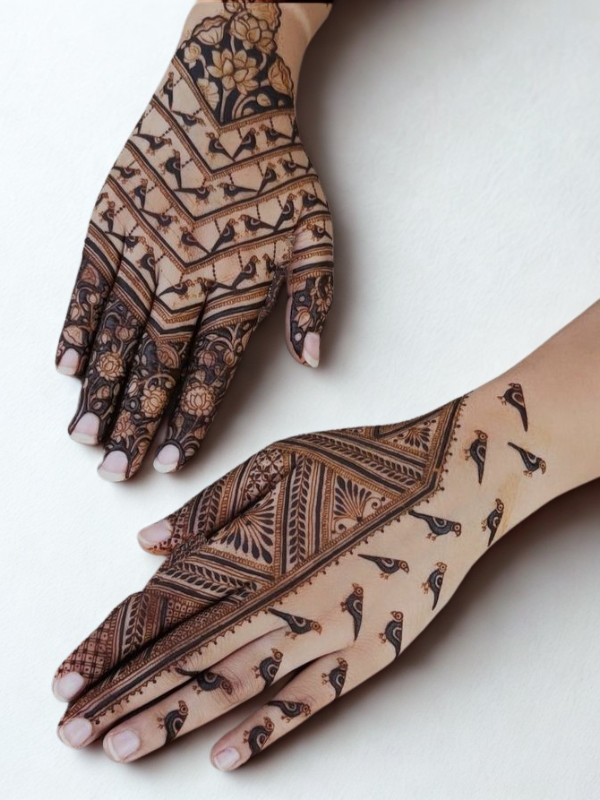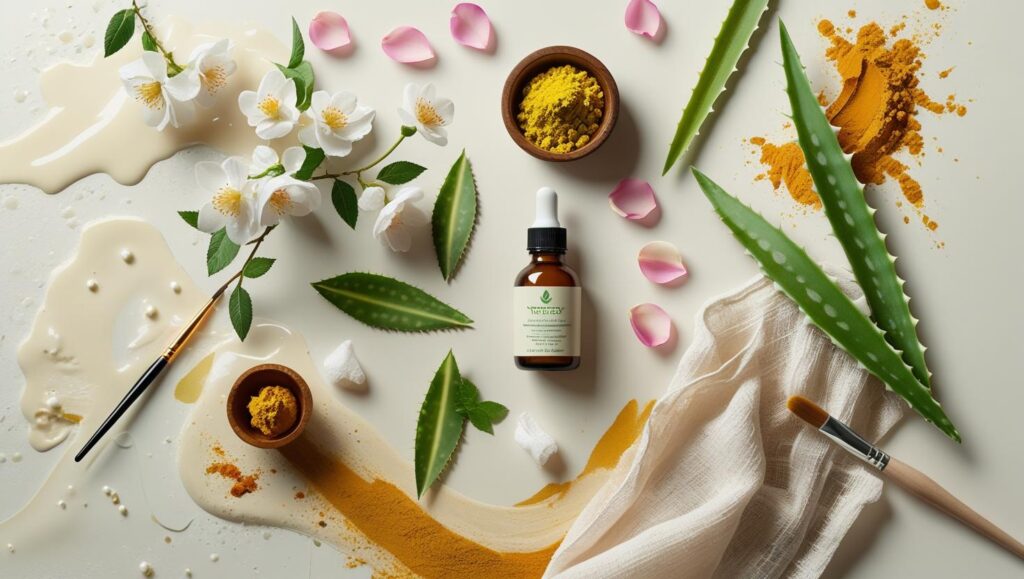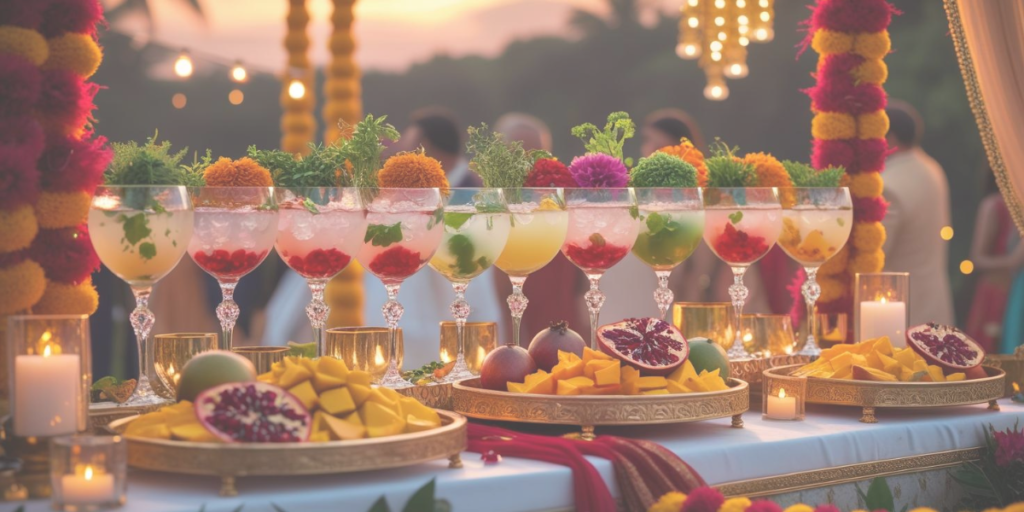Bridal mehndi (henna) is an essential wedding tradition, and in 2025, designers are blending bold patterns with intricate detailing. Some brides prefer full-hand mehndi designs covering the front and back of both hands, while others opt for more minimalistic designs.
In this blog, I will share some mehndi designs that I shortlisted for my wedding, some of which I incorporated in my wedding, while others I tried on Karvachauth, Hariyali Teej and other post-wedding events.
Full Hand Bridal Mehndi Designs
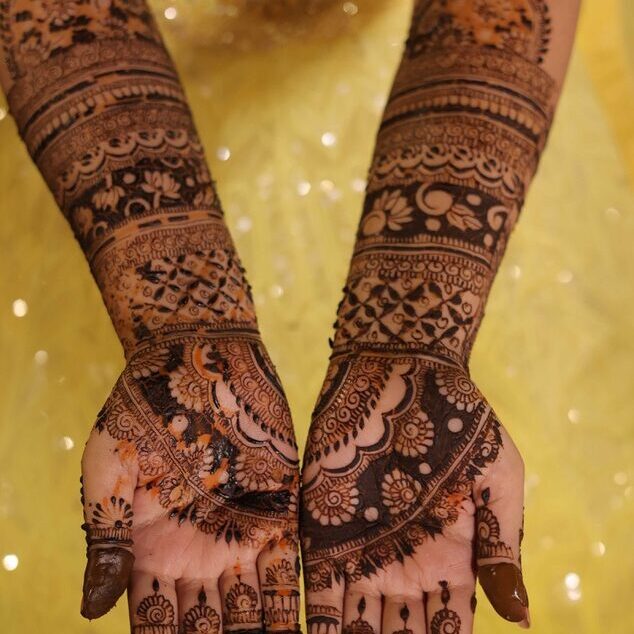
Full-hand bridal mehndi designs are a classic choice, covering fingers to wrists (or elbows) in rich detail. These patterns often weave together lotus flowers, peacock figures, paisleys, and vines so that no space is left empty.
Traditional Indian bridal mehndi is known for being very dense and intricate, using motifs like lotus and peacock throughout.
In 2025, however, some brides prefer a simple and beautiful full-hand look – for instance, a design might include a bold floral border with some open space, or a geometric pattern with cleaner lines.
Whether minimal or maximal, these full-hand bridal mehndi designs make a stunning statement on the wedding day.
Bridal Mehndi Design 2025: Front Hand
The front (palm-side) of the hand is another popular canvas. Bridal Mehndi design 2025 front hand styles often feature a large central motif, such as a lotus mandala, an elaborate peacock, or other floral art, surrounded by smaller patterns.
Brides seeking an elegant mehndi design might choose this approach for a focal point.
For the maximum impact, many opt for an intricate mehndi design that covers the entire palm with mandalas and flowers. In all cases, designers balance dense art with some skin showing (especially near the thumb and wrist) so the overall look remains graceful.
Bridal Mehndi Design 2025: Back Hand
The back of the hand offers a place for graceful, sweeping designs. Bridal Mehndi design 2025 back hand arrangements often mix trailing vines, leaves and bold motifs.

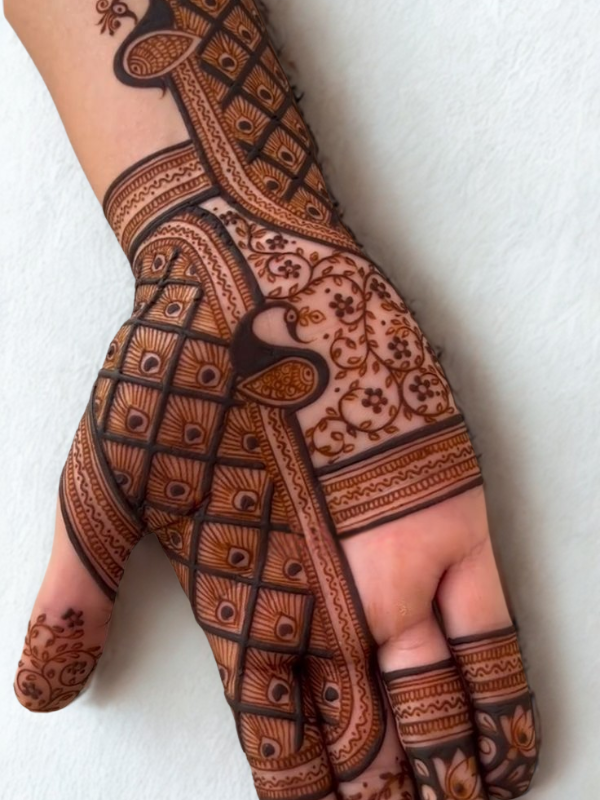
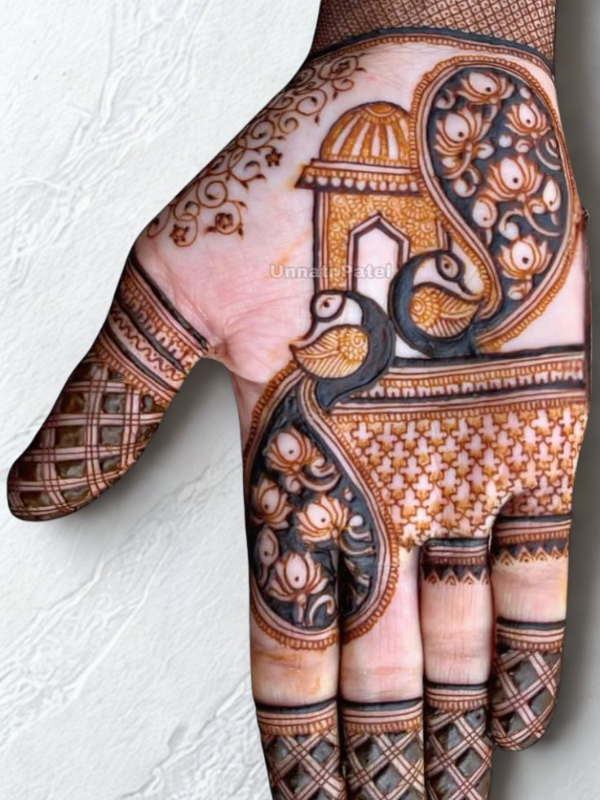
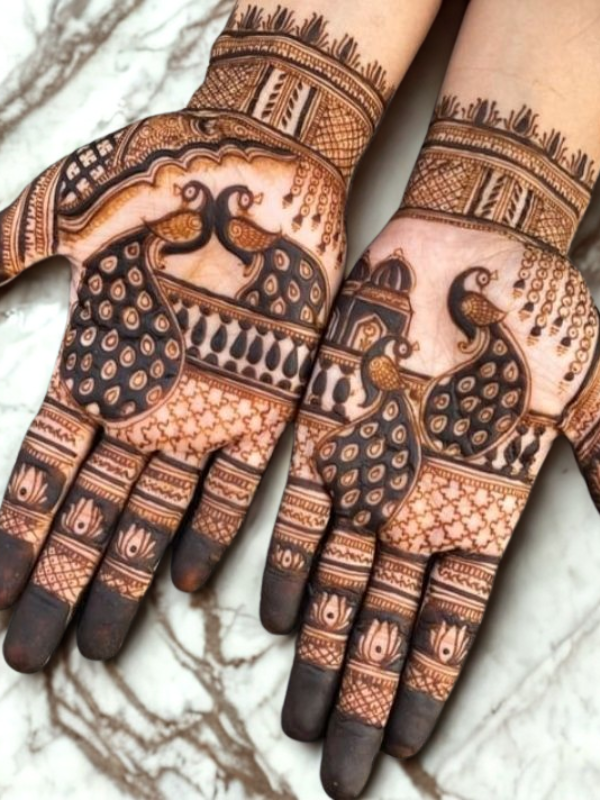

Many modern back-hand designs in 2025 embrace traditional symbols (like lotus flowers or goddess figures) but arrange them with plenty of open space.
These “simple and beautiful” mehndi designs – using one floral garland or a repeating pattern – are very popular. Whether drawn in a continuous vine or as several accents, back-hand designs can be minimalist and eye-catching, showing a touch of bridal flair without filling every inch of skin.
Arabic Bridal Mehndi Design 2025
Arabic (or Indo-Arabic) style mehndi remains a top choice for brides who want simple bridal mehndi designs. These Bridal Mehndi design 2025, Arabic patterns use flowing vines, flowers and paisleys with intentional gaps. Because they use fewer lines and more open space, Arabic designs take less time and henna paste (saving on cost).

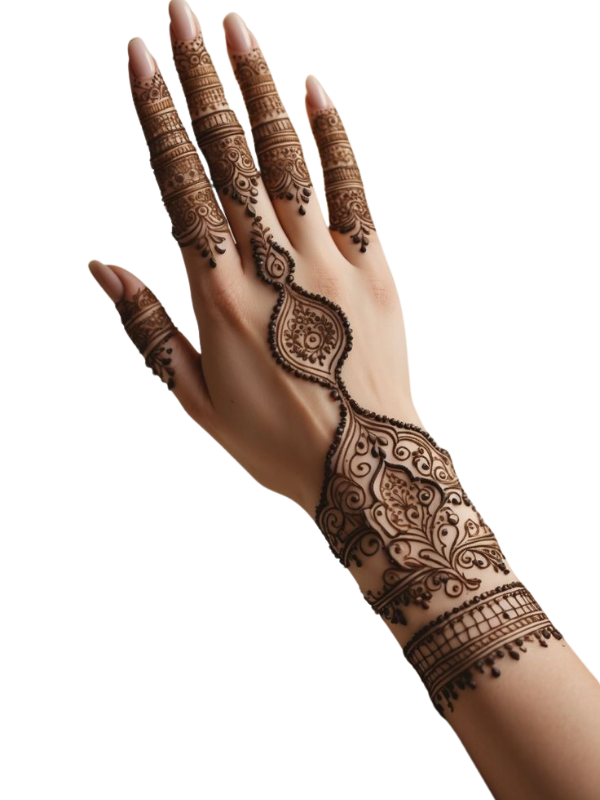
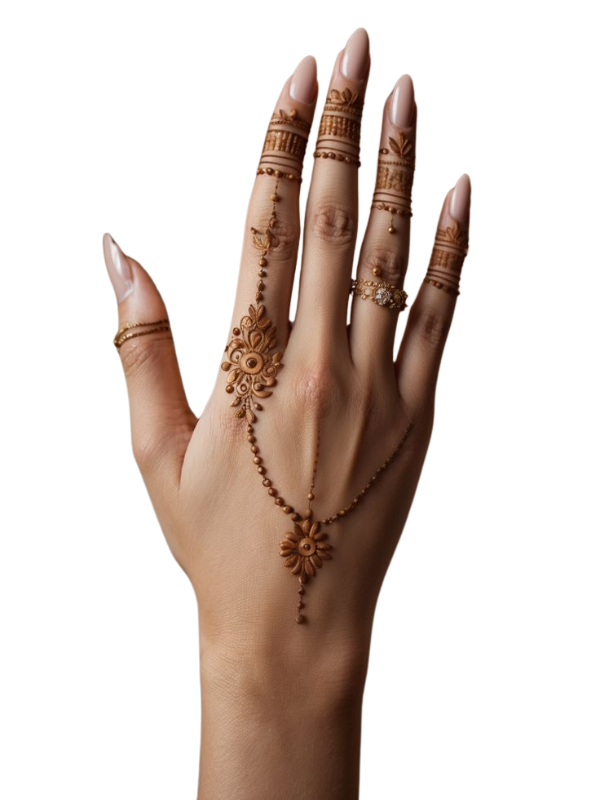
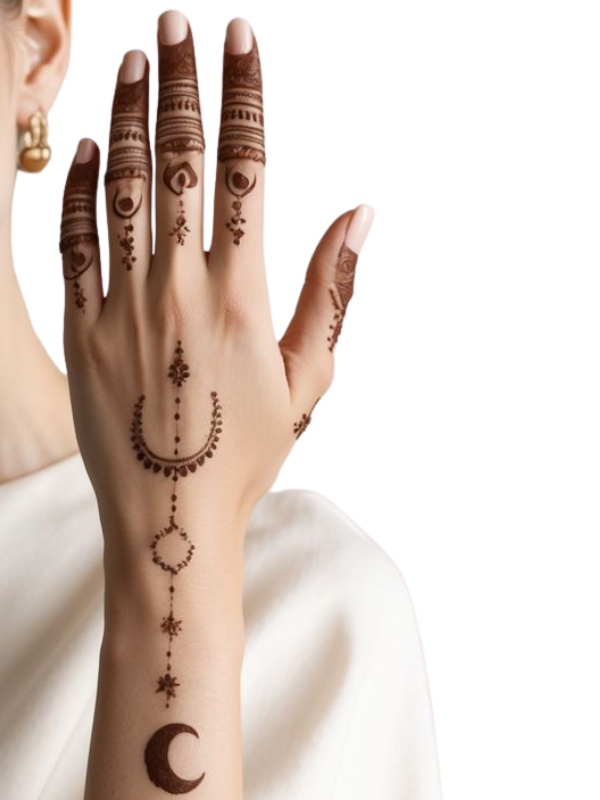
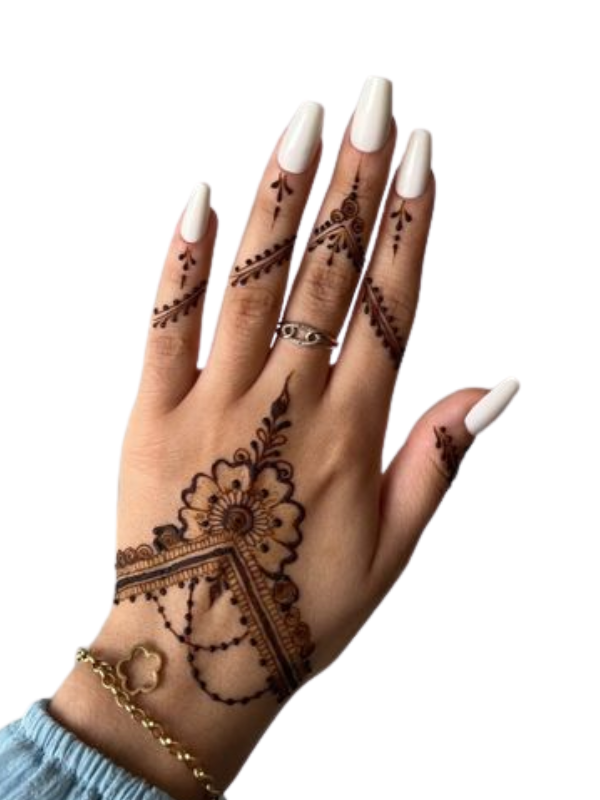

For example, an Arabic bridal mehndi might highlight a few large floral motifs on the side of the palm and elegant vine work on the back of the hand, giving a modern yet traditional feel. If you prefer elegance without heaviness, an Arabic-style design is ideal.
Elegant and Intricate Bridal Mehndi Designs
Many brides opt for elegant mehndi designs that look sophisticated. These usually blend thin, ornate motifs (like fine lacework or dots) with balanced space for a refined effect.














A common approach is to combine delicate florals and paisleys with light geometric borders. Such intricate mehndi designs require skill but give a luxurious finish. In 2025, mixing traditional art (flowers, paisleys) with contemporary twists (geometric lines, modern motifs) is a big trend.
For example, a design might feature a lace-like lattice of florals across the palm, or a symmetrical floral-peacock composition covering the hand in detail. These high-detail patterns make the mehndi itself feel like a statement accessory.
Pro tip: Show your mehndi artist reference images of the level of intricacy you want to nail the look.
Finger Mehndi Designs
For a modern twist, try finger mehndi designs. These cover just the fingers and a small motif on the palm instead of full-hand art.
Contemporary finger mehndi designs often draw rings and bands on each finger, or small floral/mandala patterns at the finger joints. The palm might have a single circular medallion or remain mostly blank.







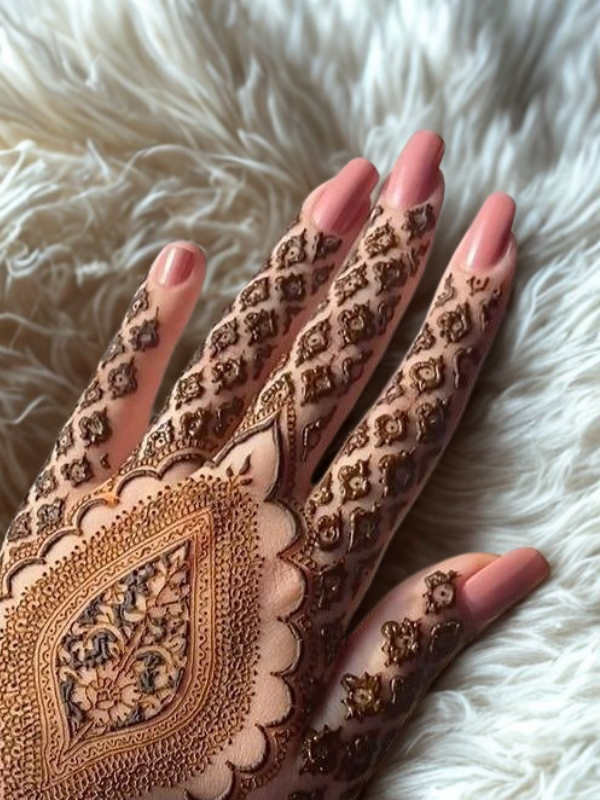



This minimalist approach is perfect if you want a pop of henna artistry without the long application time. It looks chic and leaves the rest of the hand open for jewellery or nail art.
Bracelet Style Mehndi Designs
Bracelet (or cuff) style mehndi designs are also trending. These create a decorative “henna bracelet” around the wrist, often with motifs trailing onto the palm. In the image above, lotus and vine patterns form a thick band at the base of the hands, mimicking an ornate bracelet.






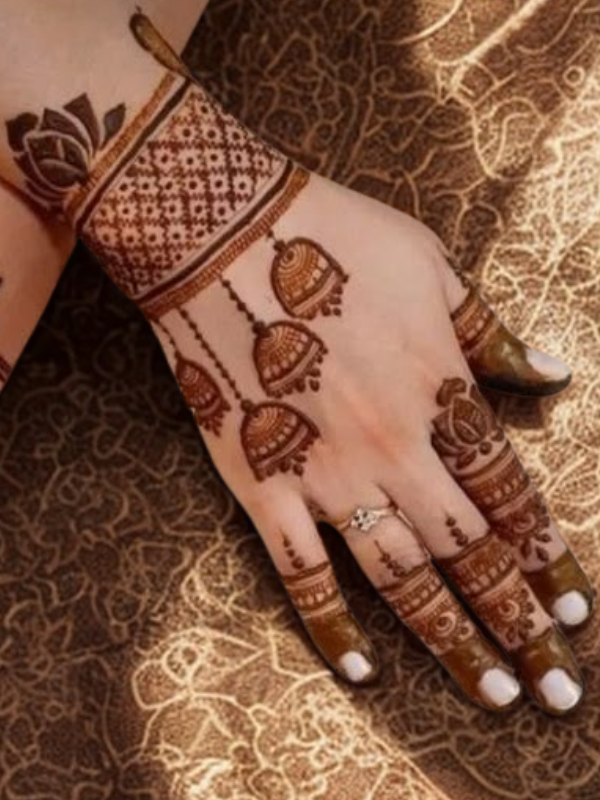
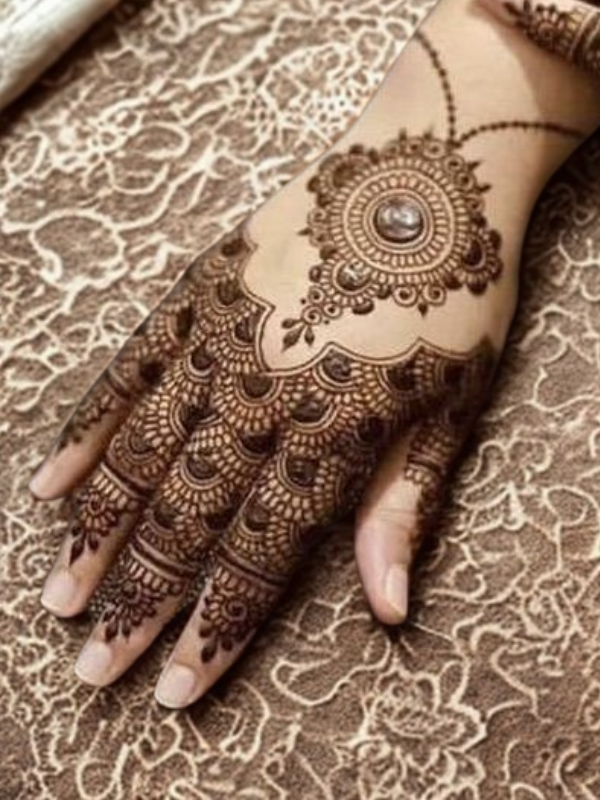
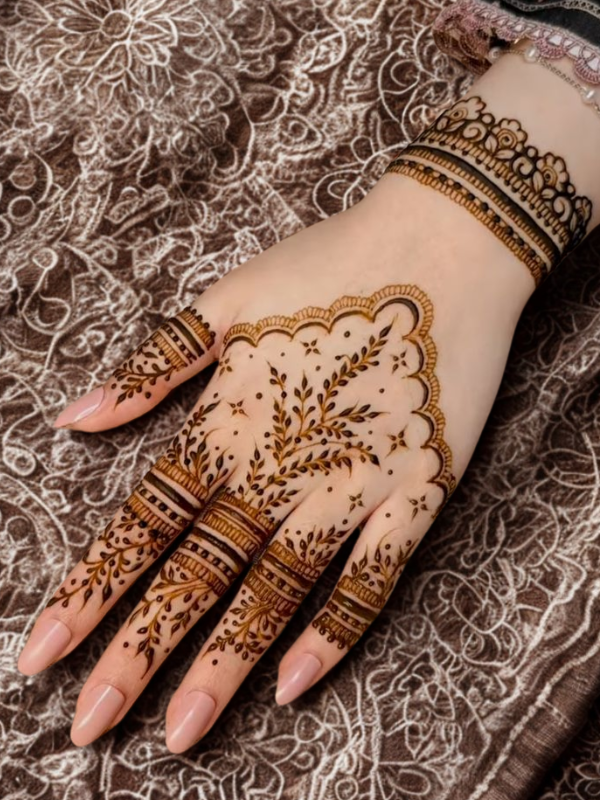


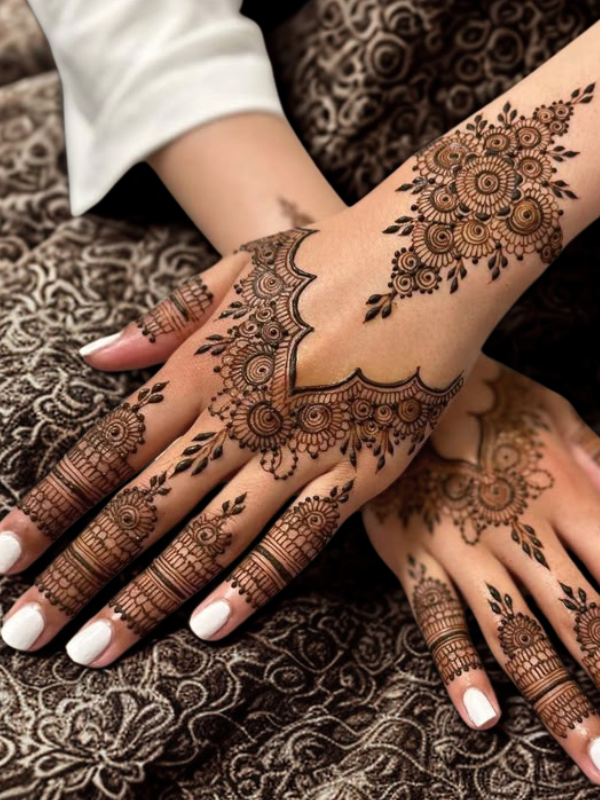
In 2025, brides pair these bracelet-style mehndi designs with complementary vine or floral lines up the palm or fingers. The result is glamorous yet practical: a bit of henna elegance that accentuates bangles, without covering the entire hand.
This style looks especially nice with sheer sleeves or bangles showing off the design.
Thematic Mehndi Motifs (Elephant, Lotus, Peacock, Rose)
Many brides choose special motifs for meaning or beauty. Popular themes include:
- Elephant mehndi design: The elephant symbolises wisdom and good luck, adding regal charm to mehndi. Elephant motifs (often paired with vines or floral accents) give a cultural, majestic look to bridal mehndi.

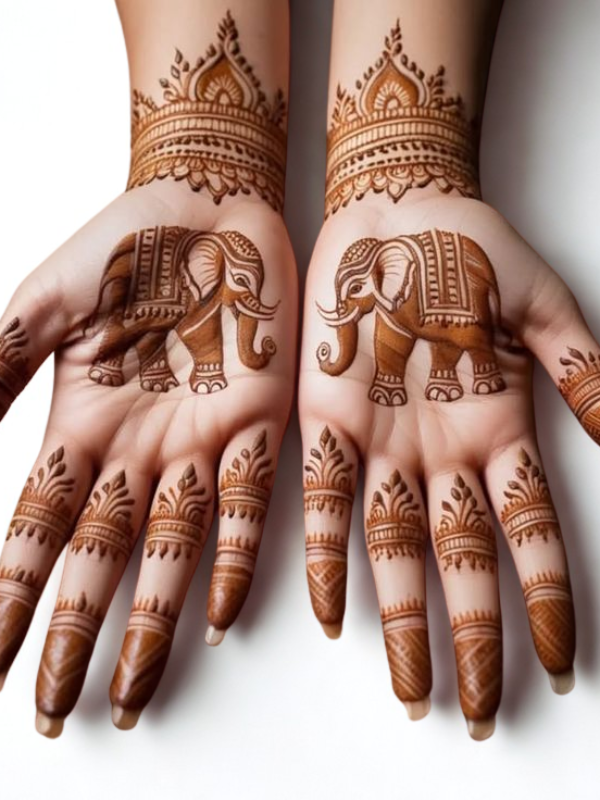
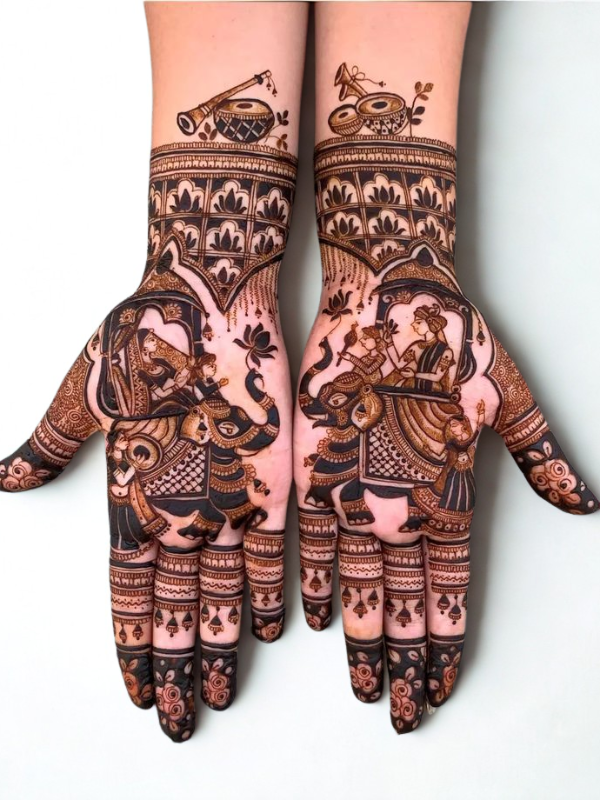
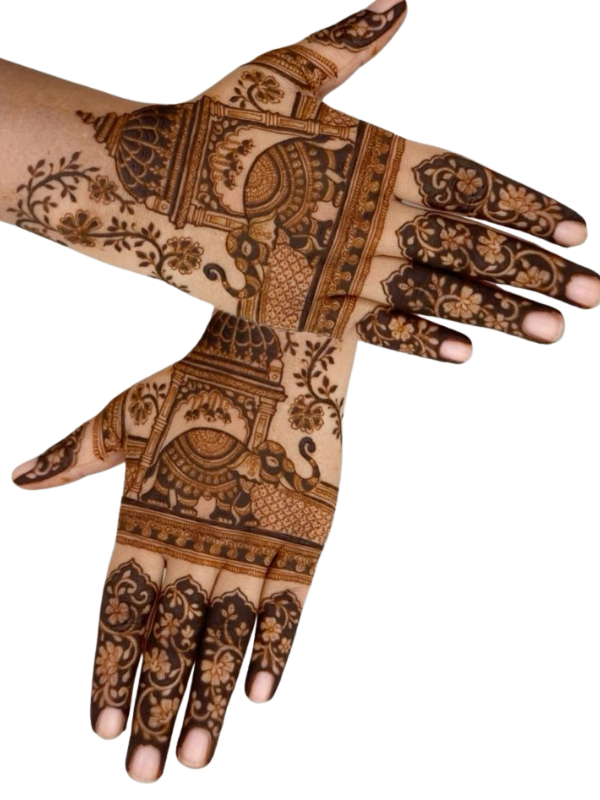
- Lotus mehndi design: The lotus signifies purity and beauty. It’s a traditional bridal symbol often incorporated into front- or back-hand designs. Lotus flowers paired with swirl patterns can fill the palm gracefully.


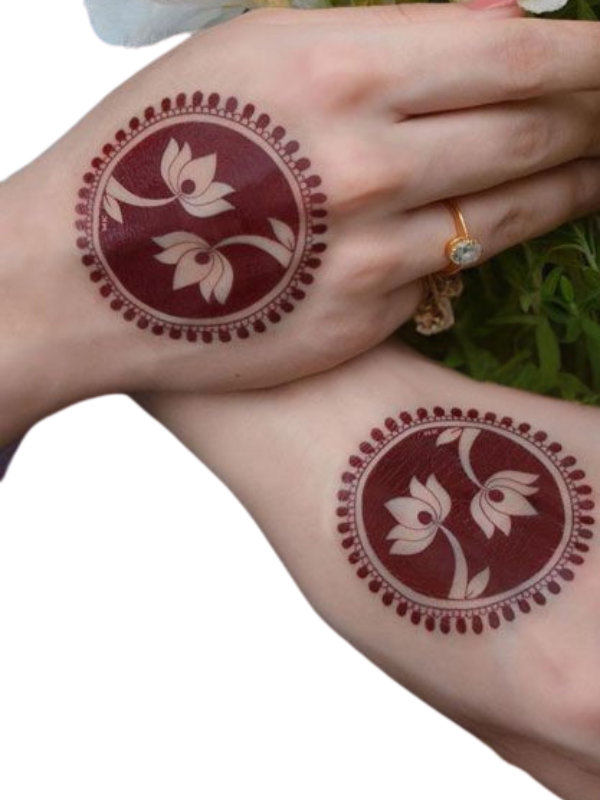
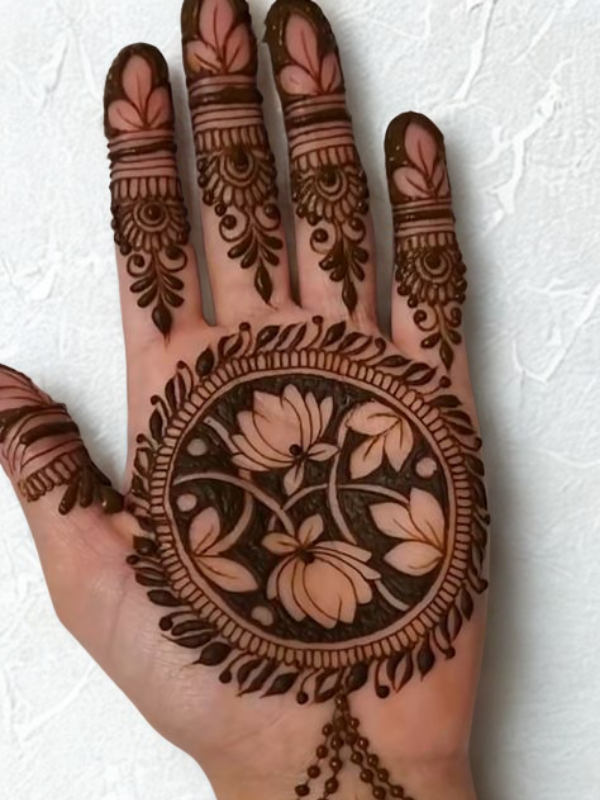
- Peacock mehndi design: The peacock represents grace and love. Peacock-inspired designs (using the bird’s feathers or silhouette) are classic for bridal art. They add elegance and are often used in full-hand and arch patterns.

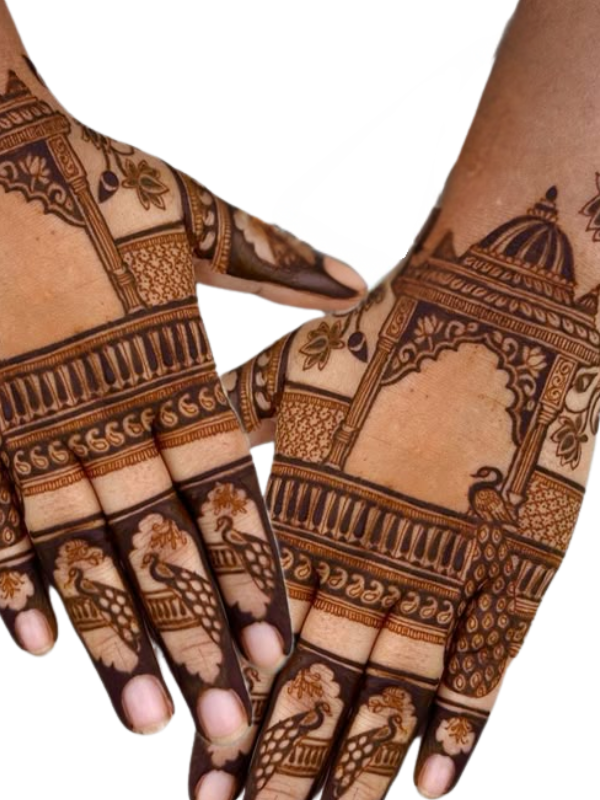
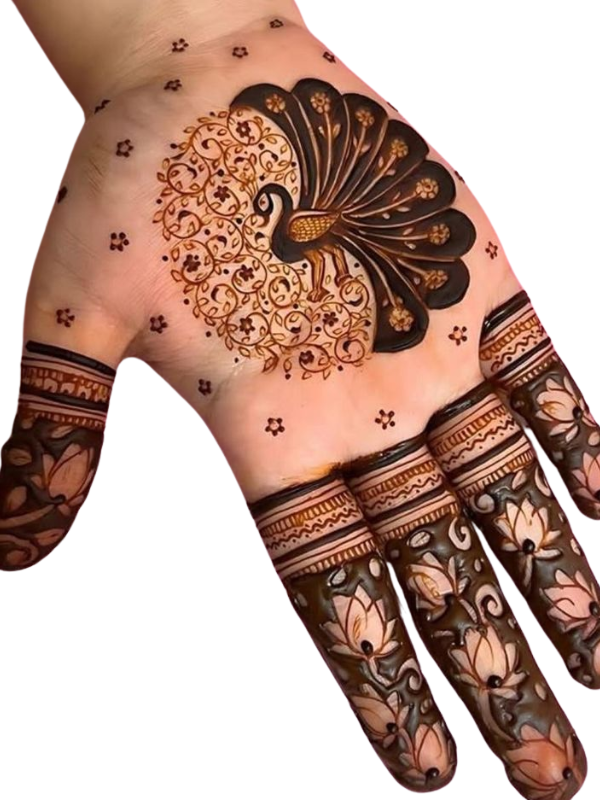
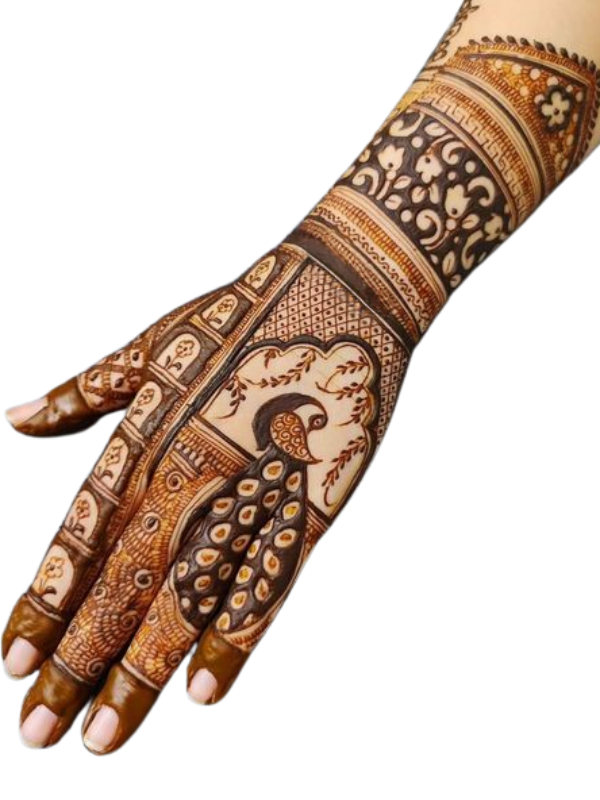
- Rose mehndi design (backhand): Roses have become a trendy motif in mehndi. A back-hand rose design might show a cluster of full blooms and vines (as in many popular designs) for a romantic, modern feel.

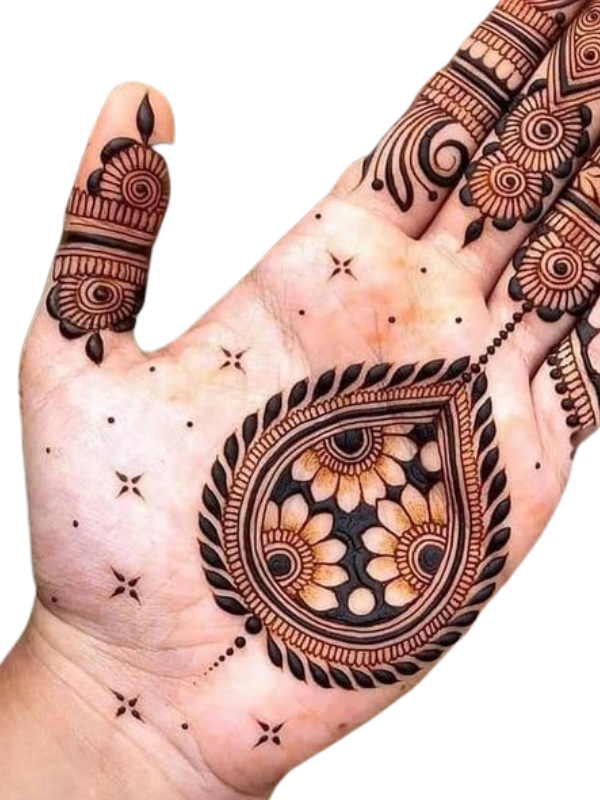
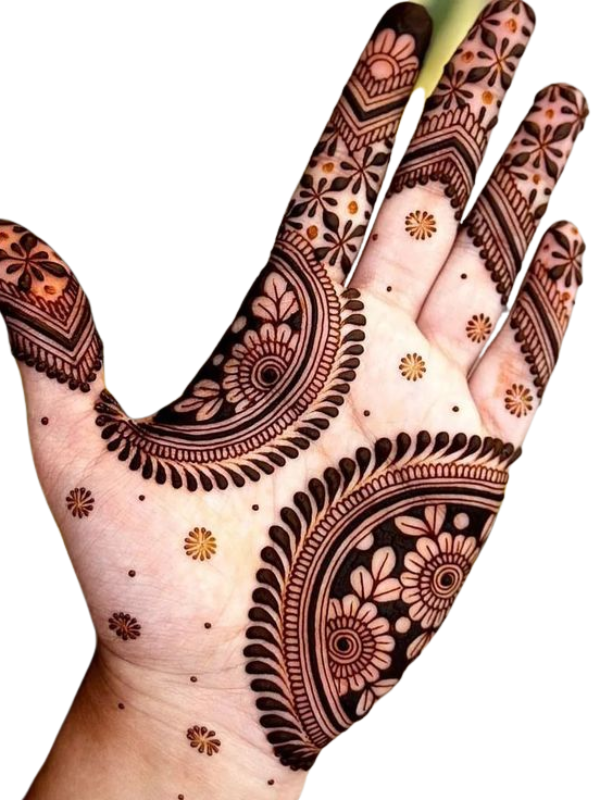
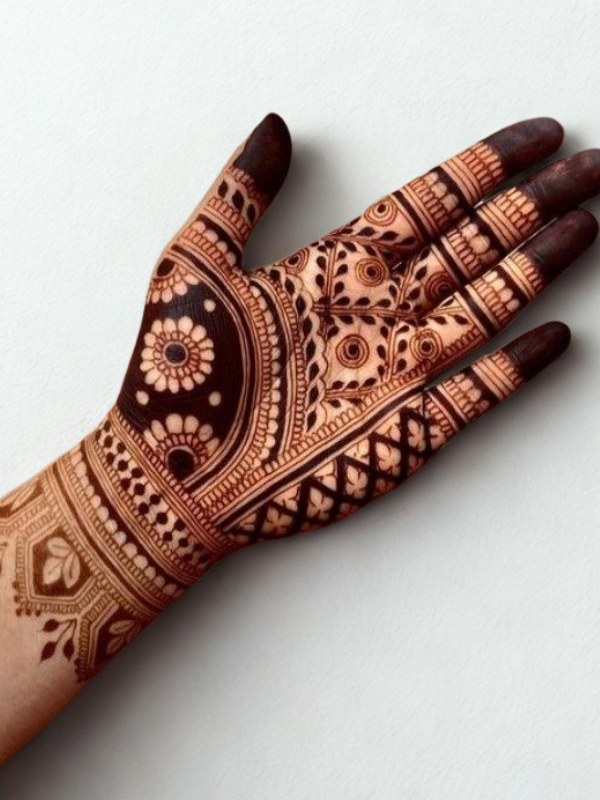
- Chaand Mehndi design: This is a graceful and symbolic style featuring crescent moon motifs, often paired with stars, florals, or intricate patterns. Inspired by the moon’s beauty and its spiritual significance in many cultures, this design represents calmness, femininity, and new beginnings.



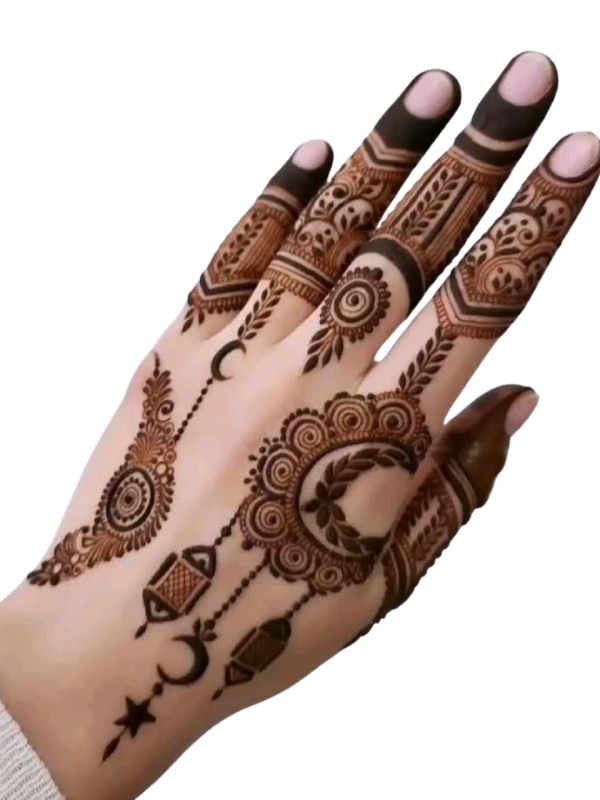
Bridal Mehndi Design Sticker
If time is very tight, consider mehndi design stickers or stencils. These are temporary decal sheets that you press onto the skin to leave a henna-like outline. While not a permanent stain, they let you achieve very intricate patterns almost instantly.
Wedding stores and online shops sell bridal mehndi sticker packs (e.g. 18pc stencil kits) that can be very useful.
Stickers are perfect for guests or demos, but remember to remove them after a day and patch-test for any skin reaction. (They make a fun quick alternative if a mehndi artist isn’t available in time!)
Simple Bridal Mehndi Design
Many brides gather simple bridal mehndi design photos for inspiration. “Simple” mehndi usually means clean lines and some blank space. Think Arabic floral vines, a single floral mandala, a lace-like cuff, or half-hand patterns.
These designs are quick and still eye-catching. In the gallery above, you saw examples: a leafy vine design on the back-hand and a delicate cuff on the palm. You might also try a few scattered flowers, minimal finger accents, or a half-mandala at the wrist.
These simple patterns look elegant and accentuate your outfit without overwhelming your hands.
Frequently Asked Questions
- Which type of mehndi design is best for girls?
It depends on personal style. Many brides-to-be love traditional full-hand mehndi for weddings – it covers both hands with elaborate floral, paisley and bridal motifs. Others prefer the ease of Arabic/Indo-Arabic designs, which use flowing vines and fewer details. Younger girls or casual brides often choose simple or westernised motifs (like lace patterns or geometric cuffs). Ultimately, the best design is what makes you happy: some brides pick themes (elephant, lotus, initials) that reflect their story. - How long does bridal mehndi take?
A full bridal mehndi session usually takes several hours. Professionals say a complete design can take anywhere from 3 to 10 hours, depending on coverage and complexity. For example, covering both hands and forearms with dense patterns might be 4–6 hours of work, while covering palms only or doing a very simple design might be closer to 3–4 hours. Plan for at least half a day (and bring snacks!) when you book your bridal mehndi. - What is a simple bridal mehndi design?
A simple bridal mehndi design uses minimal motifs and open space. It might feature one or two flowers, a leafy vine, or a small mandala, rather than filling every part of the hand. An Arabic-style vine, a wrist cuff with leaves, or a few small mandalas on the palm are examples of simple designs. These take less time to apply and give a graceful, understated look. (See the images above for ideas – a single floral vine or a row of dots can look elegant yet uncomplicated.) - What are the charges of simple mehndi?
Simple mehndi designs are generally inexpensive compared to bridal sets. As one example pricing guide notes, a basic, simple design might cost only a few hundred rupees – roughly ₹200–₹500 for both hands. More elaborate semi-bridal designs (partial coverage) might be ₹600–₹800 per hand. These are rough figures; actual charges depend on the artist’s rates and your city. In most cases, simple mehndi is very affordable and can even be done by junior artists or friends. - What is the cost of bridal mehndi?
Bridal mehndi cost varies widely by region and artist. In India, a full bridal mehndi (both hands, often with feet too) typically ranges from about ₹1,500 up to ₹15,000 or more. A simple (basic) bridal style might be on the lower end, while extremely intricate, double-artist or celeb designers can charge very high rates. It’s wise to get quotes from several mehndi artists. Keep in mind that bridal mehndi is usually more expensive than regular mehndi, similar to how bridal makeup costs more than daily makeup. - What is the cost of 1 hand mehndi design in India?
For just one hand, prices are roughly half of both hands. A basic design might be around ₹200–₹500 per hand, whereas a full intricate bridal-style hand could be around ₹1,000–₹2,000 for that one hand. For example, if a bridal artist charges ₹2,000 for both hands, it’s about ₹1,000 per hand. Again, these are ballpark figures – final rates vary by artist and how detailed your design is. - What is the price of sketch mehndi?
“Sketch mehndi” typically refers to outline or practice designs. Pricing for sketch-style mehndi is usually similar to regular mehndi. Based on sample pricing, a semi-bridal or detailed design (which sketch mehndi often mimics) could be around ₹600–₹1,000 per hand. If you see an artist offering “sketch mehndi”, ask if it’s charged like a bridal set. - How much should a bridal mehndi cost?
Budget accordingly: a good rule is that a decent bridal mehndi should cost a few thousand rupees in India. If you’re quoted very low (say under ₹1,000 for both hands by a professional), ask questions – it could indicate a very simple design or an inexperienced artist. A typical range might be ₹2,000–₹5,000 for both hands at a regular bridal artist. Consider it part of your wedding budget like makeup or hair. You can often save by booking a group package with your bridal party. Always agree on the price and design in advance.
Each bride’s preference is unique, so mix and match ideas – from full-hand traditional art to one-hand minimalist styles – until you find the perfect 2025 bridal mehndi that makes you feel beautiful!





